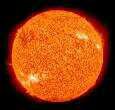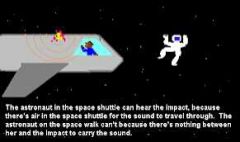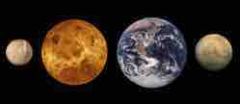![]()
![]()
![]()
Use LEFT and RIGHT arrow keys to navigate between flashcards;
Use UP and DOWN arrow keys to flip the card;
H to show hint;
A reads text to speech;
25 Cards in this Set
- Front
- Back
- 3rd side (hint)
|
palatine uvula |

- primarily serves as an accessory to speech. - The uvula is there to provide the proper lubrication for complicated human speech. |
|
|
|
Order of planets starting from the Sun |

My Very Educated Mother Just Served Us Noodles
Mercury Venus Earth Mars Jupiter Saturn Uranus Neptune |
|
|
|
How far away is the Sun from Earth
|

92,960,000 miles (149,600,000 km)
|
|
|
|
What is the Galactic Center?
|
The Galactic Center (or Galactic Centre) is the rotational center of the Milky Way.
It is located about from Earth in the direction of the constellations Sagittarius, Ophiuchus, and Scorpius where the Milky Way appears brightest. There is strong evidence consistent with the existence of a supermassive black hole at the Galactic Center of the Milky Way. |
|
|
|
What is a light year?
|
A light year is a measure of distance.
1 light year = 9.4605284 × 1015 met a unit of astronomical distance equivalent to the distance that light travels in one year, which is 9.4607 × 1012 km (nearly 6 trillion miles). informal |
|
|
|
What are stars made of?
|
73% hydrogen, 25% helium, and the last 2% is all the other elements.
|
|
|
|
When was the Big Bang?
|
13.7 billion years ago
|
|
|
|
What is a Goldilocks planet?
|
A Goldilocks planet is a planet that falls within a star's habitable zone, and the name is often specifically used for planets close to the size of Earth.
|
|
|
|
Distance from Earth to Moon |
238,900 miles (384,400 km) |
|
|
|
What is the moon? |
a celestial body that orbits another body (a planet, dwarf planet, or small Solar System body), which is called its primary, and that is not artificial. In the Solar System there are 173 known natural satellites orbiting within 6 planetary satellite systems. |
|
|
|
Why no sound in space? |

in order for sound to travel, there has to be something with molecules for it to travel through. On Earth, sound travels to your ears by vibrating air molecules. In deep space, the large empty areas between stars and planets, there are no molecules to vibrate. |
|
|
|
How does sound travel? |
Sound waves need to travel through a medium such as a solid, liquid, or gas. The sound waves move through each of these mediums by vibrating the molecules in the matter. The molecules in solids are packed very tightly |
|
|
|
What are terrestrial planets? |

Terrestrial planets share a number of common features. They are all composed mostly of rock and heavy metals. These planets have a core made of heavy metals that is mostly iron; the core is surrounded by a mantle of silicate rock. Terrestrial planets are much smaller than gas giants. The terrestrial planets also have varied terrain such as volcanoes, canyons, mountains, and craters. Another common feature among the terrestrial planets is that they have few or no moons. Mercury and Venus have none while Earth has one. Mars has two small moons. Also, the terrestrial planets do not have planetary rings like the gas planets do. The atmosphere of planets can vary from Venus’ thick carbon dioxide atmosphere to almost nothing on M |
|
|
|
How old is the universe? |
The Universe is probably about 15 billion years old, but the estimations vary.17. One problem with working out the age of the Universe is that there are stars in our galaxy which are thought to be 14 to 18 billion years old – older than the estimated age of the Universe. So, either the stars must be younger, or the Universe older. |
|
|
|
How long is a day in Mercury? |
A day in Mercury lasts approximately as long as 59 days on earth. |
|
|

White holes |
The opposite of black holes are estimated to be white holes which spray out matter and light like fountains
“A black hole is a place where you can go in but you can never escape; a white hole is a place where you can leave but you can never go back,” says Caltech physicist Sean Carroll.
For a black hole, the event horizon represents a one-way entrance; for a white hole, it’s exit-only.
According to Einstein’s general theory of relativity, the rotation smears the singularity into a ring, making it possible in theory to travel through the swirling black hole without being crushed. General relativity’s equations suggest that someone falling into such a black hole could fall through a tunnel in space-time called a wormhole and emerge from a white hole that spits its contents into a different region of space or period of time. |
|
|
|
Layers of the atmosphere |

Troposphere, Stratosphere, mesosphere,thermosphere, exosphere |
The Sound Makes The Effort. |
|
|
How old is out universe? |
The Universe is probably about 15 billion years old, but the estimations vary.17. One problem with working out the age of the Universe is that there are stars in our galaxy which are thought to be 14 to 18 billion years old – older than the estimated age of the Universe. So, either the stars must be younger, or the Universe older. |
|
|
|
How long does it take sunlight to reach earth? |
8 minutes and 19 seconds |
|
|
|
Sun's mass accounts for how much of the solar systems mass? |
The sun's mass accounts for 99.86% of the total mass of the solar system. |
|
|
|
Rainforest |
Rainforest covers only 2% of the earth surface but over 50% of plant life exists within |
|
|
|
How do our eyes view an image? |
Light beams into our eyes and meets our retina in the back of our eyes where an upside Down and backwards image appears. it's turned into electrical impulses that race to the brain and allows us to see what we need to survive. |
|
|
|
VISIBLE LIGHT |
Light that we can see: it is only a fraction of the millions of wave lengths in the vast magnetic spectrum. |
|
|
|
Some examples of light waves whose spectrum is longer than rainbows. |
Infrared, microwaves, radiowaves |
|
|
|
Examples of light waves that are SHORTER than the rainbow spectrum. |
X-ray, ultraviolet, gamma |
|

